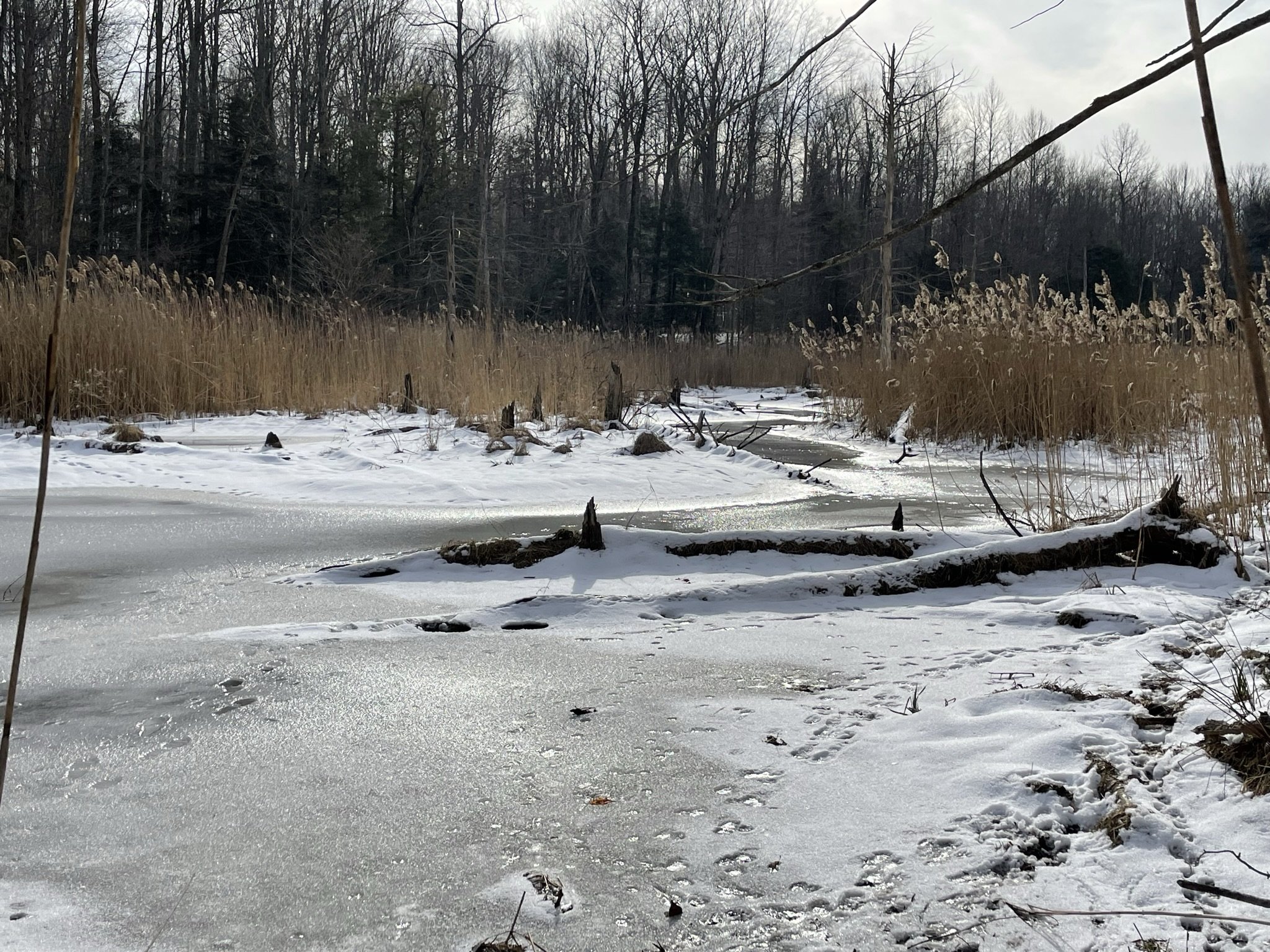From left: Liz, Will, Kevin, Larissa, Helen, baby June, Amanda, Lorna, Martha Miller and Jim Miller at the Miller Woods conservation easement in North Rose, NY.
Field Notes is a new series documenting observations from visits to Genesee Land Trust and partner conservation lands. Submit your observations and photos by emailing us at info@geneseelandtrust.org.
On a sunny winter day in early February, Genesee Land Trust staff joined Martha and Jim Miller for a tour of their woods in North Rose. The couple love woodlands, and in 2018 donated a conservation easement to the Land Trust to permanently protect their 62 acres. The property includes a mix of hardwood and softwood tree species and a creek corridor that leads to Sodus Bay, that’s often deep enough for Martha and Jim to canoe.
The land is quiet and peaceful - often we just heard birds and the crunch of boots in the snow. We were excited to have snow, as this winter has been warmer due to our changing climate. The snow allowed us to spot animal tracks throughout the property, offering insights into wildlife behavior.
Staff Field Notes, February 2023 - Miller Woods Conservation Easement
Signs of Life:
In a creek corridor leading to Sodus Bay, fallen trees and chewed stumps are signs the beavers have been busy. The area also provides habitat for ducks, muskrats, and fish including bass and catfish.
Tracks and wing scratches in the snow indicate wild turkey, white-tailed deer, racoons, and fishers. This woodland is excellent habitat for a diverse array of mammals, birds, and insects.
The long scratch lines could’ve been made by a wild turkey.
The track of a wild turkey is very distinctive.
Invasive Species:
Hemlock woolly adelgid, an invasive insect from East Asia, was spotted on a patch of tall mature eastern hemlock trees. This invasive insect has spread throughout our region over the past ten years, negatively impacting our woodland ecosystems. Learn more about hemlock woolly adelgid and what conservation groups are doing to combat its impact in this video.
Miller Woods is home to many mature hemlocks, which can grow more than 150 feet tall on trunks up to six feet in diameter. Hemlocks are a foundational species that prevent soil erosion and provide shade for streams to keep temperatures habitable for fish.
Current treatment against hemlock woolly adelgid include the application of insecticides on eastern hemlock trees and the introduction of two insects, a fly and a beetle, that prey on the small adelgids during fall, winter, and spring seasons. Genesee Land Trust has worked with conservation partners throughout our region to protect important stands of eastern hemlocks using a combination of these two treatment strategies.
In addition to “evergreen” conifers (trees with cones and green needles like the eastern hemlock in the foreground), American beech trees can hold on to their leaves in the winter. You can see a couple of these trees with tan leaves in the background. This interesting phenomenal is called marcescent, meaning the trees retain dead leaves until new leaves appear in spring. Beech trees do this so that the fallen leaves can provide nutrients to the soil in spring, to deter pests (deer don’t seem to like the taste), and/or to get moisture from snow to the tree during wintertime.
Monitoring Deer Impact:
A deer exclosure installed a few years ago at Miller Woods conservation easement will show how the woods grows when undisturbed by deer. We'll see results in 7 to 10 years, which will help the landowners make land management decisions.
The trick with a deer exclosure is to make it small enough that deer don’t try and get in. Deer can leap very high (over six feet) and could easily clear this fence but won’t try because they don’t think they’ll land safely.
Genesee Land Trust is conducting deer monitoring at multiple properties we protect and operates a deer management program at several conservation lands to limit the impact deer have on native species, including on young trees and native wildflowers. Without the large predators our woodlands used to have, including wolves and mountain lions, hunting can be an effective option to manage the impacts from deer.
The Problem With Too Many Deer:
New York State currently has more than one million deer. Too many deer on a property, especially a woodland, can create major problems. As an example, deer tend to eat sugar maple and yellow birch saplings, so a large population of deer will make these two tree species very rare and affect the overall forest diversity. If you’re not seeing many young plants or trees, it’s likely because deer are eating them.
Deer can also have impacts on other mammals through overgrazing on young trees and shrubs. This lack of undergrowth or “understory” means there’s limited places for small mammals and birds to nest and forage for food. When deer populations reach five-times the land’s capacity, birds that nest on the ground or in low shrubs can no longer reproduce. If small mammals and birds can’t find shelter, nest or reproduce they will leave to survive. If there’s nowhere else to go, populations of these species can become locally extinct. In the last 50 years, Eastern forest bird populations (including many species that rely on Miller Woods) have dropped by 27%. You can read more about the state of birds here.
Tell Us what you see and hear:
If you observe signs of wildlife or plant life at a property protected by Genesee Land Trust, please share your field notes and photos with us! We appreciate emails to info@geneseelandtrust.org with updates from the community about wildlife tracks, flowers, mushrooms, invasive species, butterflies and insects, and seasonal landscapes. We love sharing these field observations with the community and encourage you to send a selfie too!
Alerts about trash, downed trees, property damage, or other concerns are also appreciated by our land management staff and volunteers.
Photos by Elliotte Bowerman







